| |
|
|
 |
|
| The Women of the Bible: a selection of critics’ reviews |
|
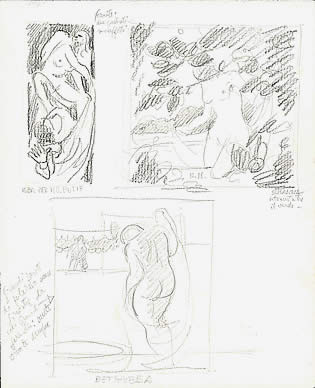 |
| |
|
|
|
|
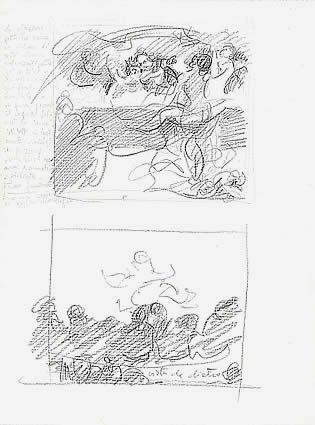 |
| |
|
|
|
|
| Preliminary sketches for Potiphar's
wife, Susanna, Bathsheba and Salome |
 |
 |
 |
 |
 |
|
| |
|
|
|
|
|
| |
|
From the wealth of reviews written about this cycle, which appeared
periodically in the daily newspapers when there were exhibitions,
and over the years, in art and cultural magazines, here are a few
brief extracts taken from longer reviews by some of the more significant
contributors. |
|
| |
|
|
|
|
|
| |
|
|
|
|
|
| |
|
|
|
|
|
| |
|
|
|
|
|
| |
|
|
|
|
|
| |
|
|
|
|
|
| |
|
|
|
|
|
| |
|
|
|
|
|
| Giorgio Segato: Ernani Costantini’s
Biblical cycle |
|
| |
|
|
|
|
|
| |
|
The cycle on the women of the Bible accompanies […] above
all Costantini’s work as a painter of large scale wall paintings,
predominantly for churches. In this new challenge […] Ernani
has cultivated and matured his narrative vein and his capacity for
synthesis with broad pictorial gestures which are well defined, airy,
clearly visible and interpretable from a distance, marked, underlined,
filled with expertly emphasised atmospheric vibrations, syncopated
and modulated as a sign of comprehension and emotional and moral
participation.[…]
Costantini has been part of the artistic panorama of Venice and the
Veneto from the postwar period until now, but if this reference is
particularly evident in his other artistic genres, in his portraits
and his sacred and religious art Ernani Costantini breaks away in
order to assimilate a much vaster horizon, a quantity and quality
of different references and first among all, that of reaffirming
a direct, immediate figurative communication, informative and emotional
with the widest audience, using the signs, the images, revealing
a sensuality and allegories which still belong to us, recreating
gestures and prospective leanings which unleash his artistic sensibility
and generous narrative inventiveness to the greatest extent. |
|
| |
|
|
|
|
|
| |
|
|
|
|
|
| |
|
Giorgio Segato, Il ciclo Biblico
di Ernani Costantini [The Biblical cycle of Ernani Costantini],
in Da Eva a Maria [From
Eve to Mary], MMV, Padua
1987 |
|
| |
|
|
|
|
|
| |
|
|
|
|
|
| |
|
|
|
|
|
| |
|
|
|
|
|
| |
|
|
|
|
|
| |
|
|
|
|
|
| |
|
|
|
|
|
|
|
|
|
|
| Sergia Jessi Ferro: A spiritual and aesthetic
message |
|
|
|
|
|
|
| |
|
|
|
|
|
|
|
|
|
|
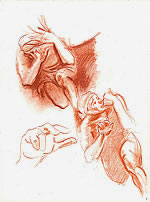 |
| |
Study for the figure of
Joseph fleeing Potiphar's wife |
|
|
Costantini removes from these twelve female
figures that aura which is a combination of mythical and sacred with
which history has cloaked them and returns them to us in their humanity
which remains unchanged over time. Twelve characters, twelve different
situations, a single denominator the “female dimension”[…]
The artist has once again achieved the miraculous feat of speaking
to us through a universal language.
[…] Costantini has read deeply into the minds of these women
and through an expert use of the language of colour and similarly
through his composition of images he lays open to us the world of
their secret thoughts.
[…] To wonder why in our times he felt the need to measure
himself against such a theme using these forms would mean our rejection
of the spiritual message which comes from them, and being able to
appreciate the enchantment of these colours which are the light of
life and seduction |
|
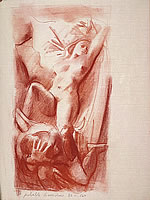 |
|
Studio per moglie di Potifar |
| |
|
|
|
|
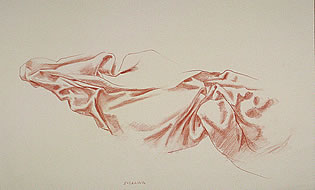 |
| |
|
|
|
|
| Study for Susanna: drapery |
 |
 |
 |
 |
 |
|
| |
|
|
|
|
|
| |
|
Sergia Jessi Ferro, Un
messaggio spirituale ed estetico [A spiritual and aesthetic message],
in Da Eva a Maria [From
Eve to Mary], MMV,
Padua 1987 |
|
| |
|
|
|
|
|
| |
|
|
|
|
|
| |
|
|
|
|
|
| |
|
|
|
|
|
| |
|
|
|
|
|
| |
|
|
|
|
|
| |
|
|
|
|
|
|
|
|
|
|
Guido Perocco: Beyond representation |
|
|
|
|
|
|
| |
|
|
|
|
|
|
|
|
|
|
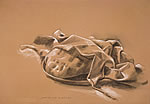 |
| |
Detail for Herod's banquet
|
|
|
The pictorial work is of a rare consistence
and the expertise in the composition of the twelve imposing paintings,
with an effort equal to that of the great painters of old who worked
on canvases of vast dimensions and the task of communicating through
painting, to a community both attentive and spiritually prepared to
respond, the analogical meaning between the image and the literary
text […]
The bold effort of Costantini beats any hesitance and returns to
the origins of this discourse |
|
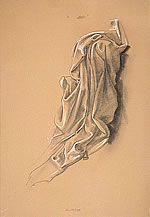 |
|
Study of drapery for Holofernes in Judith |
| |
|
|
|
|
|
|
|
| |
|
Guido Perocco, Al
di là della
figurazione [Beyond representation], in Da Eva a Maria [From
Eve to Mary],
MMV, Padua 1987 |
|
|
|
| |
|
|
|
|
|
|
|
| |
|
|
|
|
|
|
|
| |
|
|
|
|
|
|
|
|
|
|
| |
|
|
|
|
|
|
|
|
|
|
| |
|
|
|
|
|
|
|
|
|
|
| |
|
|
|
|
|
|
|
|
|
|
| Paolo Rizzi: The women of Ernani Costantini,
Biblical, yet so modern |
|
|
|
|
| |
|
|
|
|
|
|
|
|
|
|
| |
|
[…] The painter has read the sacred texts and interpreted
them freely. No iconographic memories […] that of Ernani Costantini,
this time more than ever, is the way of an auroral naturalism.
[…] The protagonists, as far as Mary of Nazareth, move outside
time. They are women of yesterday and, at the same time, of today.
Something which strikes us makes us think.
[…] The spiritual link however must be unravelled by us. It
is the spectator who invests the image with a hint of religiousness.
Strangely Ernani Costantini, a man of culture and faith, also actively
involved in social life, makes no apology. Neither does he impose
any credo.
He “reads” the Bible logically and interprets it with
the spirit of today. Perhaps it is for this reason that his “natural
mystery” moves us. |
|
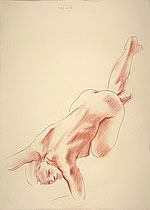 |
|
Study for Delilah |
| |
|
|
|
|
|
|
|
|
|
|
| |
|
Paolo Rizzi, “Le donne di Ernani
Costantini, Bibliche, eppure così moderne” [The
women of Ernani Costantini, Biblical, yet so modern], Il
Gazzettino, Venezia, 6th march 1987 |
|
|
|
|
|
|
| |
|
|
|
|
|
|
|
|
|
|
| |
|
|
|
|
|
|
|
|
|
|
| |
|
|
|
|
|
|
|
|
|
|
| |
|
|
|
|
|
|
|
|
|
|
| |
|
|
|
|
|
|
|
|
|
|
| |
|
|
|
|
|
|
|
|
|
|
| Marco Goldin: The women of the Bible,
twelve canvases by Ernani Costantini … |
|
|
|
|
| |
|
|
|
|
|
|
|
|
|
|
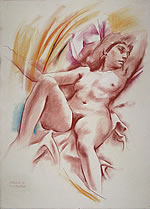 |
| |
Study for Potiphar's wife |
|
|
[…] Ernani Costantini has weaved
his figurative reflection, with an articulation which alternates moments
of high drama and other typically contemplative ones.
[…] Today, Costantini aims to present to us, with great boldness,
a piece of work similar to those of old, while trying to embrace,
with one great sweeping stroke, such a vast temporal arc.
Between Eve and Mary the entire history of mankind is contained,
and the painter’s project is the challenge of retracing in
the various scenes an element of unity and coherence.
It is for painting, which is often poorly interpreted, to speak,
communicate, make contact, and reach under our skin. Costantini’s
should be a lesson on figures, symbols, images, and colours: the
rediscovery of an ancient element of language which is sometimes
believed to be lost […]
Ernani Costantini’s depiction spreads out in a carefree and
quiet form […] His figures are coherent, and above all, always
dominated by a soft light, which makes the harmony of tones a fundamental
characteristic. Though the figures are suspended in an atmosphere
which is removed from the world, they still, again and again, cling
to the earth, on which this grand scenario is built […] |
|
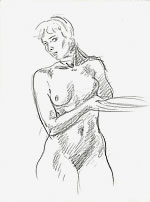 |
|
Study for Salome: Herodias |
| |
|
|
|
|
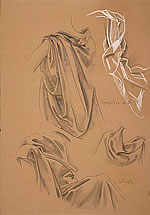 |
|
Study for Salome: Herod's robes |
| |
|
|
|
|
 |
 |
 |
 |
 |
|
| |
|
|
|
|
|
| |
|
Marco Goldin, “Le donne della
Bibbia, dodici tele di Ernani Costantini …” [The women
of the Bible, twelve canvases by Ernani Costantini …], La
vita del Popolo, Treviso, 8th march 1987 |
|
| |
|
|
|
|
|
|
|
|
|
|
| |
|
|
|
|
|
|
|
|
|
|
| |
|
|
|
|
|
|
|
|
|
|
| |
|
|
|
|
|
|
|
|
|
|
| |
|
|
|
|
|
|
|
|
|
|
| |
|
|
|
|
|
|
|
|
|
|
| Enzo di Martino: Biblical “fresco” by
Costantini |
|
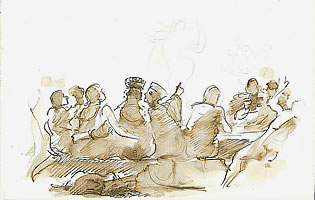 |
| |
|
|
|
|
| Study for Salome: Herod's
banquet |
| |
|
|
|
|
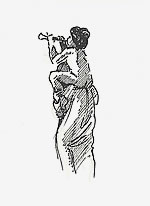 |
|
Study for Salome: the flute player |
 |
 |
 |
 |
 |
|
| |
|
|
|
|
|
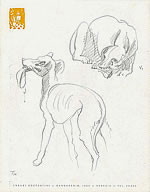 |
| |
Study for Salome |
|
|
[…] Through the use of a coarse
and essential painting style, almost as if painting a mural, Costantini
puts together a great biblical fresco with an essentially epic feel.
However, on closer inspection, the author constructs a work which
is also profoundly religious even though the various female characters
are shown in “flesh and
blood” and therefore in the fullness of their humanity. […] |
|
| |
|
|
|
|
| |
Enzo di Martino, “Affresco biblico
di Costantini” [Biblical “fresco” by Costantini],
from Arte, Milan, march 1987 |
|
| |
|
|
|
|
| |
[…] By occasionally enriching the
settings and the scenes with other figures and numerous additional
historical details which make it more alive and comprehensible, Costantini
makes great use of his expert and efficient painting technique which
is able, also from a strictly psychological standpoint, to bring the
women of the Bible closer to our contemporary sensibility, thus rendering
them up-to-date. […] |
|
| |
|
|
|
|
|
| |
|
Enzo di Martino,
from Il Gazzettino, 2002. |
|
| |
|
|
|
|
|
| |
|
|
|
|
|
| |
|
|
|
|
|
| |
|
|
|
|
|
| |
|
|
|
|
|
| |
|
|
|
|
|
| |
|
|
|
|
|
| |
|
|
|
|
|
|
|
|
|
|
 |
 |
 |
 |
 |
 |
 |
 |
 |
 |
 |
|

